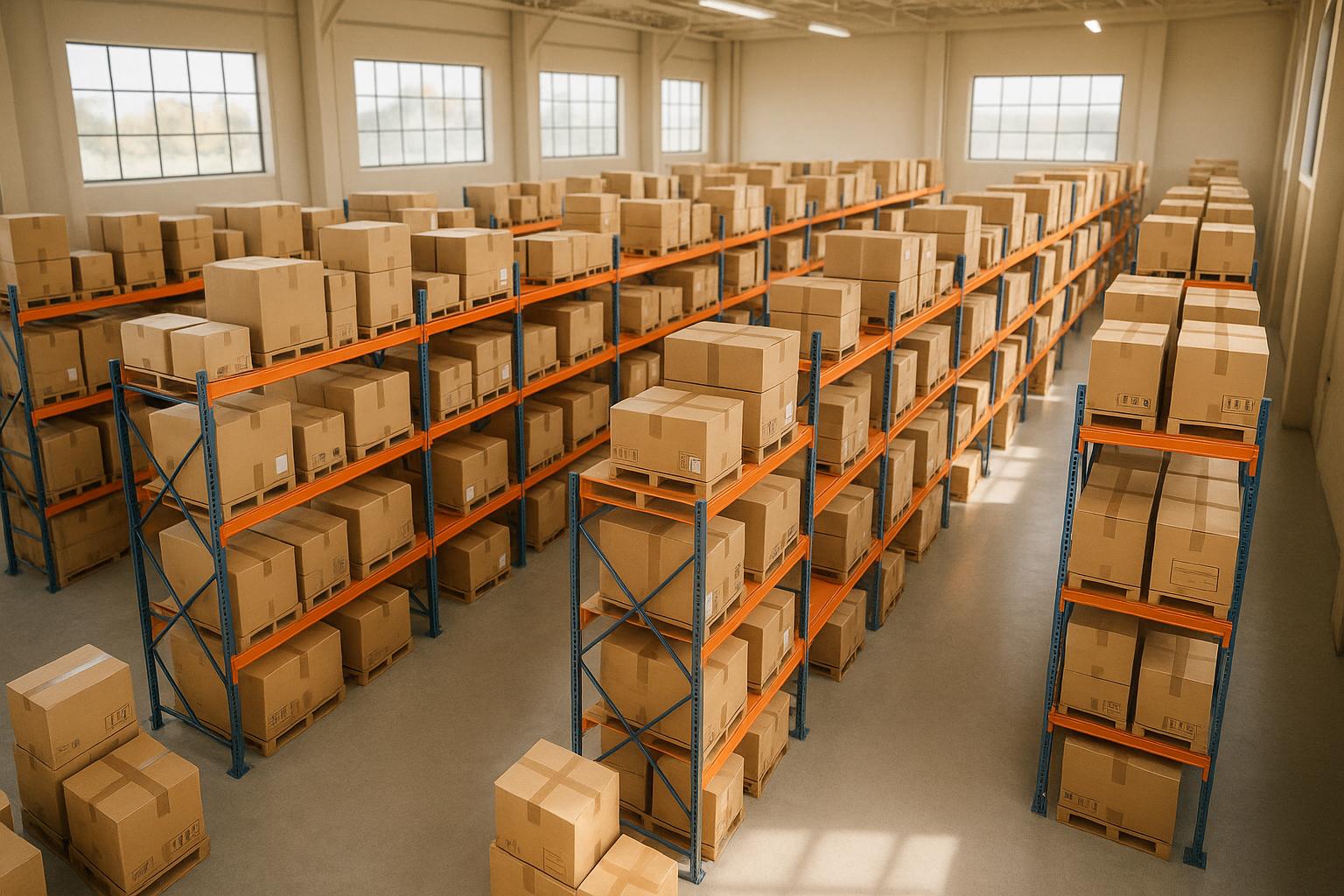Custom Workflow Design for E-commerce Fulfillment

E-commerce fulfillment is no longer a one-size-fits-all process. Custom workflows are the key to solving inefficiencies, cutting costs, and ensuring happier customers. Here's why they matter and how to get started:
- Why you need custom workflows: Generic systems create bottlenecks, increase errors, and slow down operations. Tailored workflows align with your unique needs, like product handling, shipping zones, and customer expectations.
- Benefits: Faster order processing, fewer errors, better customer communication, and the ability to scale without constant overhauls.
- How to create them: Analyze your current process, define clear goals, and use automation tools to simplify tasks. Test and optimize regularly to keep workflows efficient.
- Tools to consider: Platforms like Zapier, Power Automate, and 3PL providers like JIT Transportation can help integrate and streamline your operations.
Custom workflows aren't just about improving efficiency - they directly impact customer satisfaction and business growth. With the right design and tools, your fulfillment process can become a competitive advantage.
Creating Automation Rules for Ecommerce Fulfillment
Benefits of Custom Workflow Design in E-commerce
Custom workflow design takes e-commerce fulfillment to the next level by tailoring operations to meet specific business needs. Unlike generic systems, these workflows provide a strategic edge that supports growth and strengthens customer loyalty.
Better Efficiency
Custom workflows remove unnecessary friction by aligning processes with your unique operations. By reducing manual tasks and optimizing resources, your team can focus less on adjustments and more on strategic priorities. This leads to faster processing times and lower labor costs per order.
Built-in verification steps also help minimize errors. For example, if your inventory includes fragile electronics or temperature-sensitive goods, workflows can include checks at critical moments to prevent costly mistakes. Catching potential issues early saves both time and money, creating a smoother and more cost-effective operation overall.
Every improvement - whether it’s time saved on manual tasks or errors avoided - adds up to significant cost savings over time.
Better Customer Experience
Tailored workflows directly improve what your customers experience when they shop with you. Faster order processing becomes achievable because your systems are designed to match how you actually operate, not based on generic templates.
Accuracy in delivery also gets a boost. For businesses that ship across time zones or handle items with specific shipping needs, custom workflows ensure the right products reach the right destinations through the best methods.
Personalized service becomes much easier, too. Custom systems can flag VIP customers, handle special requests more effectively, and remember customer preferences for consistent service.
Communication improves as well. With custom workflows, you can send timely updates - like tracking information or notifications about delays - at the moments that matter most to your customers. This proactive approach helps address concerns before they escalate.
The result? Customers receive their orders faster, encounter fewer issues, and feel more informed throughout the process. This translates to higher satisfaction, repeat business, and positive word-of-mouth - key factors for sustainable growth.
Scalability for Growing Businesses
One of the biggest advantages of custom workflows is their ability to grow alongside your business. Generic systems often struggle as order volumes increase, but custom workflows are designed to handle growth seamlessly.
With scalability built in, your workflows can better manage higher order volumes without hitting bottlenecks. Tasks are distributed more efficiently, and it’s easier to identify when additional resources are needed.
Custom workflows also help control costs as your business scales. Instead of hiring more staff at the same rate as your growth, efficient workflows allow you to handle increased volume with smaller labor cost increases. This is especially crucial during peak seasons when temporary staff need to be onboarded quickly.
Flexibility is another major plus. Whether you’re launching new products or entering new markets, custom workflows can adapt more easily than rigid, one-size-fits-all systems. This means you can bring new ideas to market faster and with fewer implementation headaches.
Technology integration is smoother, too. Custom workflows are designed to work with your specific tech stack, making it easier to add new tools or upgrade existing systems without overhauling your entire process.
In the long run, custom workflows create a fulfillment operation that supports your growth rather than holding it back. Instead of reworking your processes every time you scale, you’ll have a system that evolves with your business, providing a solid foundation for future success.
Steps to Build Custom Workflows for E-commerce Fulfillment
Creating workflows tailored to your e-commerce fulfillment needs requires a structured approach: analyze your current operations, set clear goals, and continuously refine your processes.
Review Current Fulfillment Processes
Start by mapping out every step of your fulfillment process, from order receipt to delivery. Time each step to pinpoint where delays or inefficiencies occur. This includes tasks like inventory checks, picking, packing, labeling, and shipping.
Pay close attention to manual handoffs between systems or team members. These transitions often lead to delays or errors. Look for bottlenecks in areas like data entry, approval steps, or interdepartmental communication.
Track errors over a 30-day period to identify recurring issues. Are incorrect items being picked? Are shipping addresses frequently wrong? Are packages arriving damaged? By understanding these patterns, you can design workflows that address root causes instead of just reacting to problems.
Also, review how your workflows hold up during busy periods like holidays or sales events. Processes that work well during normal times may fall apart when order volumes surge. Document how these spikes impact processing times and error rates.
Use all this information to set measurable goals for improving your fulfillment process.
Define Business Requirements
With a clear view of your current process, outline what you want your ideal fulfillment system to achieve. Focus on specific, actionable targets. For example, instead of aiming for "faster shipping", define a goal like "same-day processing for orders placed before 2:00 PM EST."
Consider the nature of your products when setting requirements. Fragile items, for instance, need workflows that prioritize careful handling, while perishable goods require temperature control and expedited shipping.
Your customers’ expectations should shape many of your requirements. If they expect real-time tracking updates, your workflow must include automated notifications. If you cater to business clients, you might need bulk processing capabilities or detailed reporting.
Think about future growth as well. If you're handling 500 orders a day now but expect to scale to 2,000 within 18 months, your workflows should be built to handle that growth without requiring major overhauls.
Finally, list all the systems involved in your fulfillment process - your e-commerce platform, inventory software, accounting tools, and shipping carriers. Your workflows should ensure seamless communication between these systems.
Once your requirements are clear, it's time to implement automation to streamline operations.
Use Automation and Integration Tools
Choose tools that enhance your current systems rather than replacing them entirely. API-based integrations often offer the flexibility needed to customize workflows to your exact needs.
Start with inventory synchronization. Real-time updates prevent overselling and eliminate the need for manual stock checks. Automate alerts to notify you when popular items are running low.
Next, implement order routing automation. Set rules that automatically assign orders to the best fulfillment location based on factors like customer proximity, stock availability, and shipping preferences. This reduces decision-making time and speeds up deliveries.
Incorporate automated quality checks at key points in your workflow. For example, weight verification during packing can catch errors before items are shipped. Address validation tools can also minimize shipping delays and returns.
Automate customer communication to keep them informed without adding extra work for your team. Configure triggers for emails or text messages that provide order confirmations, updates, shipping notifications, and delivery confirmations. Include tracking details and estimated delivery dates to enhance the customer experience.
Test, Monitor, and Optimize
Start small by piloting your new workflows with a limited set of orders. This allows you to identify and resolve issues without disrupting your entire operation. Run the pilot for at least two weeks to capture a range of order patterns and volumes.
Before making changes, establish baseline metrics like processing times, error rates, customer satisfaction scores, and labor costs per order. These benchmarks will help you measure the impact of your new workflows.
During the rollout, monitor performance daily. Use real-time dashboards to track key metrics and quickly spot issues. Pay special attention to any increases in processing time or error rates, as these often signal bottlenecks.
Gather feedback from team members who use the workflows every day. They can provide insights into inefficiencies or areas for improvement that might not be obvious from the data. Schedule weekly check-ins during the first month to capture this feedback while it's still fresh.
Make adjustments incrementally. Small changes are easier to implement and less likely to create new problems. For instance, if packing is slowing down, consider tweaking the picking order rather than overhauling the entire process.
After peak periods, review how your workflows performed. Identify what worked well and what didn’t, and use these lessons to prepare for the next busy season.
Document all changes and their outcomes. This creates a valuable resource for future improvements and helps new team members understand the reasoning behind your workflows. Include both successes and lessons learned from changes that didn’t go as planned.
sbb-itb-eafa320
Tools and Technologies for Custom Workflow Design
To execute custom workflows effectively, having the right tools and technology in place is just as important as designing streamlined processes. Choose a tech stack that integrates smoothly with your current systems and can grow alongside your business.
Workflow Automation Software
Automation tools are the backbone of modern workflow design. Here are a few standout options:
- Zapier: With connections to over 5,000 apps, Zapier allows you to automate tasks without writing a single line of code. For example, you can set up workflows that automatically update inventory across different sales channels or create customer service tickets when shipping delays occur.
- Microsoft Power Automate: Perfect for businesses already using Microsoft products, this tool offers pre-built templates for common e-commerce scenarios like order processing and inventory updates. It’s particularly useful for handling complex workflows that involve conditional logic.
- Nintex: Designed for enterprise-level automation, Nintex offers advanced features like real-time monitoring, drag-and-drop workflow builders, and robust error handling. It’s ideal for managing high-volume orders and approval processes.
These tools often include API connectivity, action logs for troubleshooting, and detailed reporting capabilities. However, keep in mind that more advanced platforms may come with a steeper learning curve. If you’re new to automation, it’s often better to start with simpler tools and transition to more powerful solutions as your team becomes comfortable with the technology.
Once you’ve set up automation, consider integrating logistics solutions to further optimize your workflows.
3PL Logistics Solutions by JIT Transportation

JIT Transportation provides third-party logistics (3PL) services that align seamlessly with custom workflows. Their offerings include:
- Pick & pack and kitting & assembly: These services can be tailored to your specific needs, ensuring that product bundling, subscription boxes, and other complex orders meet your brand standards while benefiting from JIT’s operational expertise.
- ERP integration: By connecting directly to your enterprise resource planning system, JIT eliminates the need for manual data entry and provides real-time visibility into orders and inventory across all sales channels.
- Vendor-managed inventory (VMI): JIT takes automation a step further by monitoring your stock levels and reordering products automatically based on pre-set rules. This minimizes the risk of stockouts while reducing excess inventory costs.
- Returns management (RMA): Their returns service streamlines the handling of product returns. JIT can inspect items, update inventory, and process refunds or exchanges according to your policies, all while maintaining detailed records for analysis.
Additionally, JIT’s nationwide warehouse network enables faster delivery through zone skipping and optimized order routing. By integrating these logistics solutions into your workflows, you can ensure quicker delivery times and consistent customer experiences.
To refine your workflows even further, dive into data and analytics tools for actionable insights.
Data and Analytics Tools
Data is the key to understanding and improving your workflows. Here’s how some leading tools can help:
- Google Analytics 4: This tool provides insights into customer behavior, such as cart abandonment rates and checkout times. Use this data to identify hidden bottlenecks in your fulfillment processes.
- Tableau: Known for its powerful data visualization capabilities, Tableau allows you to create dashboards that combine metrics like inventory turnover rates, order processing times, and customer satisfaction scores. Its predictive analytics can help you plan for demand spikes and seasonal trends.
- Microsoft Power BI: With seamless integration into Microsoft’s ecosystem, Power BI offers real-time reporting and automated tracking of KPIs like shipping delays, order accuracy, and labor costs. Share these reports across teams to keep everyone aligned.
- Custom reporting tools: As your operations grow, tools like Looker or Sisense can pull data from multiple sources - e-commerce platforms, warehouse systems, and shipping carriers - to create unified dashboards.
Focus on metrics that directly impact your operations and customer satisfaction, such as order processing time, inventory accuracy, and on-time shipping rates. Monitor these metrics daily during workflow adjustments to catch and resolve issues quickly.
Real-time alerts are another game-changer. Set up notifications for critical events like inventory shortages or shipping delays to address problems before they escalate. To test workflow changes, consider A/B testing by running parallel processes for a subset of orders. This approach lets you evaluate performance and make data-driven decisions before rolling out updates across the board.
Best Practices for Scaling E-commerce Operations with Custom Workflows
Scaling e-commerce operations requires well-thought-out workflows that can handle increasing order volumes and adapt to shifting market conditions.
Data-Driven Decision Making
Rely on solid data to guide your decisions. Focus on metrics that directly impact costs and customer satisfaction, such as order processing times, inventory accuracy, and shipping delays. These indicators provide a clear picture of how your workflows are performing.
Automated reporting tools can help you monitor these metrics and compare them to industry benchmarks. For example, if processing times spike during peak seasons or certain product categories delay fulfillment, you can tweak workflows before these issues escalate. Regularly reviewing metrics - ideally on a weekly basis - allows for timely, incremental adjustments.
Take it a step further with predictive analytics. By analyzing historical data trends, you can anticipate potential bottlenecks and act before they occur. Whether it’s scaling up staffing, adjusting inventory, or refining processing procedures, this proactive approach ensures your workflows stay efficient, even during demand surges.
Ongoing Workflow Optimization
Make workflow reviews a regular practice. Monthly evaluations of performance data, combined with team feedback, can uncover areas needing improvement. This routine helps you address minor issues before they snowball into bigger problems.
When testing workflow changes, start small. Apply modifications to a limited number of orders to measure their impact. This method reduces risk while providing clear insights into what works.
Seasonal spikes in order volume demand flexibility. Document adjustments made for busy periods so you can reuse them in the future without starting from scratch.
Cross-training your team is another smart move. When employees are familiar with multiple processes, you can quickly adapt to unexpected shifts in order patterns or staffing levels.
Lastly, aim for workflows that are simple and standardized. Overly complex processes with too many decision points can lead to errors and slow down operations. Regularly streamlining your workflows ensures they remain efficient as your business expands.
Partnerships with Scalable 3PL Providers
While internal optimizations are crucial, external partnerships can significantly enhance your growth. Working with scalable third-party logistics (3PL) providers can improve efficiency and help you manage volume fluctuations without needing to expand your own warehouse space or hire more staff. For instance, JIT Transportation's scalable infrastructure allows businesses to handle these challenges effortlessly. Their nationwide network also enables expansion into new markets without the need for local fulfillment centers.
Integrating your systems with an ERP solution simplifies operations by eliminating manual data entry. This seamless communication between your systems and your 3PL provider ensures orders move smoothly from sale to shipment, reducing errors and saving time.
Vendor-managed inventory services are another game-changer. Instead of juggling stock levels across locations and sales channels, your 3PL partner can handle reordering based on demand forecasts and pre-set rules. This automation lets your team focus on growth rather than operational headaches.
Look for 3PL partners offering flexible service options that can scale as your business grows. Services like pick-and-pack, kitting and assembly, and returns management should be adaptable to your current and future needs. This flexibility ensures you won’t need to switch providers or renegotiate contracts as your business evolves.
Geographic distribution is key when scaling. 3PL providers with strategically located warehouses can position inventory closer to your customers, cutting shipping costs and delivery times. Plus, having multiple warehouse locations acts as a safety net in case one site faces disruptions.
Lastly, choose partners who offer real-time reporting and visibility into your operations. Access to up-to-date information on inventory levels, order statuses, and shipping performance is essential for making informed decisions. A strong 3PL partnership, like one with JIT Transportation, integrates seamlessly with your custom workflows, acting as an extension of your team. Transparent communication and shared performance goals ensure that both parties work toward the same objectives.
Conclusion: How Custom Workflow Design Drives E-commerce Success
Custom workflow design is the backbone of successful e-commerce operations. Throughout this guide, we’ve seen how tailored workflows can transform fulfillment processes, from the moment an order is placed to the final delivery.
When workflows are designed to fit your specific business model, customer needs, and product lineup, the results are clear: fewer errors, faster processing times, and reduced costs. These improvements naturally lead to a better customer experience. Think about it - accurate orders, quicker shipping, and clear communication build trust and satisfaction, encouraging repeat purchases and glowing reviews. Plus, workflows built with growth in mind make scaling seamless, allowing your operations to expand without hitting bottlenecks during busy seasons or periods of rapid growth.
But it doesn’t stop there. Data-driven decisions and ongoing performance monitoring keep workflows sharp and adaptable. This isn’t a “set it and forget it” situation - it’s a continuous process that grows alongside your business.
Strategic partnerships are another game-changer. Scalable 3PL providers like JIT Transportation offer advanced infrastructure, nationwide networks, and specialized services - all without the need for massive upfront investments. These partnerships integrate smoothly with your existing workflows, giving you the flexibility to scale efficiently and handle challenges head-on.
The true strength of custom workflows shines during tough times - whether it’s a holiday rush, supply chain hiccup, or unexpected growth spurt. Businesses with well-designed, flexible workflows don’t just weather these storms; they turn them into opportunities to outpace competitors stuck with rigid, one-size-fits-all systems.
In today’s competitive e-commerce landscape, success hinges on workflows tailored to your unique needs and fine-tuned with performance insights. Paired with the right technology and strategic partners, custom workflows are the driving force behind sustainable growth and unmatched customer satisfaction.
FAQs
How do custom workflows enhance customer satisfaction in e-commerce fulfillment?
Custom workflows can significantly boost customer satisfaction by streamlining essential tasks like order processing, picking, packing, and shipping. The result? Faster deliveries and fewer mistakes, making sure customers get their orders on time and exactly as expected.
When businesses integrate automation and advanced technology into their workflows, they can cut down on errors, speed up processes, and manage large order volumes with ease. On top of that, designing workflows around customer preferences - such as offering personalized packaging or flexible delivery options - can elevate the shopping experience, fostering trust and encouraging long-term loyalty.
How can I identify and fix inefficiencies in my e-commerce fulfillment process?
To tackle inefficiencies in your e-commerce fulfillment process, start by digging into key performance metrics like order accuracy, processing times, and shipping delays. These numbers can reveal patterns or bottlenecks that might be slowing things down.
Take a close look at your warehouse setup, inventory management, and transportation methods. Are your storage areas cluttered or poorly organized? Are manual processes causing unnecessary delays? Identifying and simplifying redundant steps in these areas can make a big difference.
Lastly, explore automation tools and data-driven solutions to streamline workflows, minimize errors, and speed up operations. By building scalable systems, you can support business growth without compromising on reliable fulfillment.
What should I consider when selecting automation and integration tools for custom e-commerce workflows?
When choosing tools for automating and integrating custom e-commerce workflows, it's crucial to ensure they work well with your existing systems and can grow alongside your business. Opt for solutions that can adapt to changing operational demands while maintaining strong security measures and adhering to industry standards.
Key features to consider include real-time data synchronization and batch processing, as these can simplify operations and boost efficiency. Tools that easily connect with your fulfillment processes can also play a big role in improving productivity and supporting future expansion.
Related Blog Posts
Related Articles

Freight Rate Negotiation for E-commerce Brands

10 Common Supply Chain Risks and How 3PLs Solve Them

